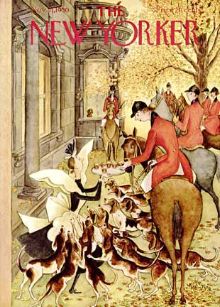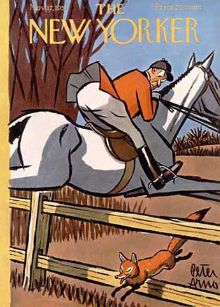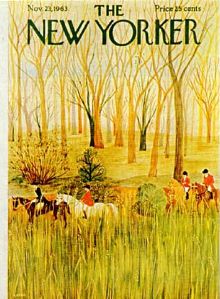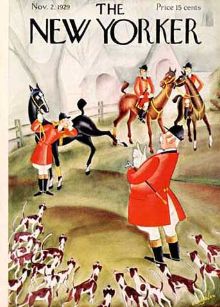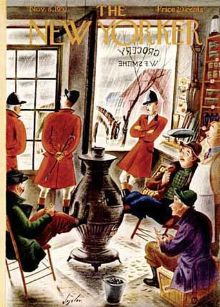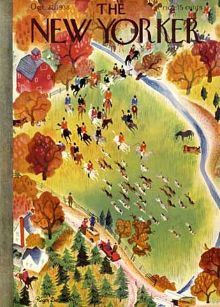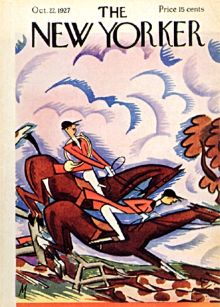2005 November
About Andrew Cusack
 Writer, web designer, etc.; born in New York; educated in Argentina, Scotland, and South Africa; now based in London.
Writer, web designer, etc.; born in New York; educated in Argentina, Scotland, and South Africa; now based in London. read more
News
Blogs
Reviews & Periodicals
Arts & Design
World
France
Mitteleuropa
Knickerbockers
Argentina
The Levant
Africa
Cape of Good Hope
Netherlands
Scandinavia
Québec
India
Muscovy
Germany
Academica
The Great War Victory Arch
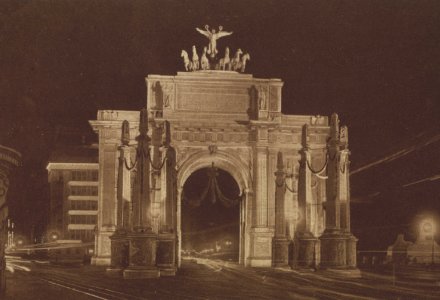
The intersection of Broadway and Madison Avenue sure is the popular place for temporary triumphal arches. After the little shootout with Spain we had a great victory parade and built the Dewey Arch for the triumphant American soldiers and sailors to march under. It also seems that we built a temporary arch for the troops returning from the First World War, photographs of which you can see above and below. The Dewey Arch is more pleasing, if you must know my thoughts upon it, but it’s still rather comely in its own right.
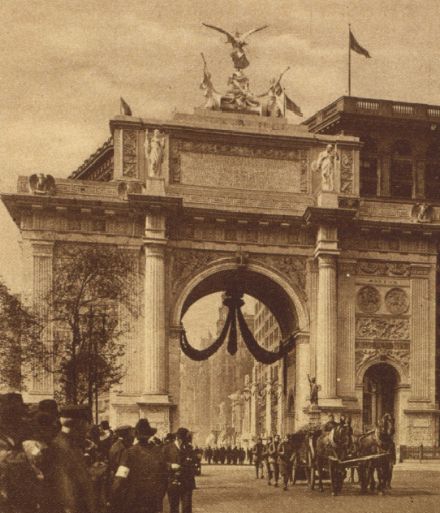
With C. in Yemen
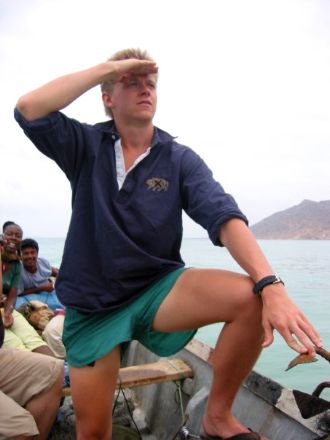
When Christopher C. was a wee lad, his daddy would bounce him on his knee and tell him of an island in the Indian Ocean named Socotra where the streets were paved with gold.
Lately, after reading the current price of gold on the Paris market in the Yemen Financial Observer, Chris decided to launch an amphibious assault on the island and seize it for himself.
Above, C. is seen leading what Chris Moreland called “the most unimpressive invasion force the world has ever seen”.
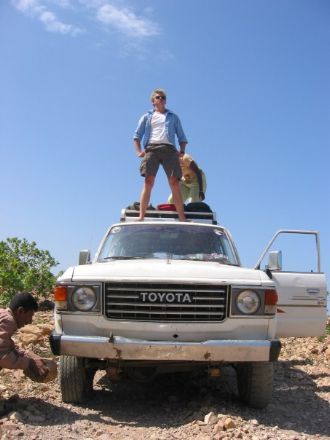
Once the expeditionary force made landfall, transportation by big ole Arab rowboat was considered logistically unsound, so the crack squad headed inland towards the capital of Socotra by means of a handy Japanese pick-up truck. Socotra! Where the streets are paved with gold!
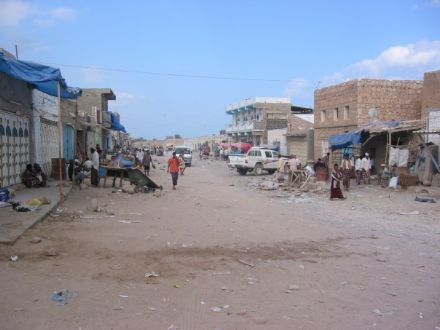
Unfortunately, like everything else his father ever told him, it was a lie.
Unless ‘gold’ is Arabic for ‘dirt’ and ‘paved’ is Arabic for ‘unpaved’, which would make Arabic a dashed silly language.
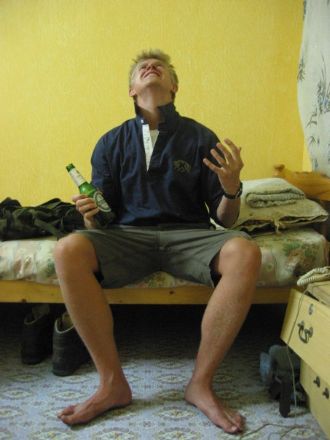
Disappointed with his anticlimactic conquest, Chris returned to the mainland where his rented room awaited.
There, he picked up a bottle of non-alchoholic beer, cursed the Gods, and questioned whether life really had any meaning after all.
Fun With Sepia

G.R.V.H.I.
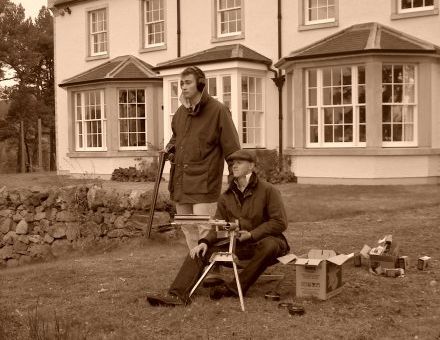
W. Calderhead and C. C..
Thanksgiving
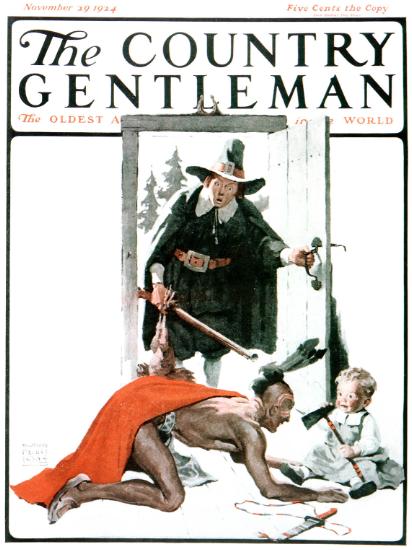
ALMIGHTY and gracious Father, we give you thanks for the fruits of the earth in their season and for the labors of those who harvest them. Make us, we beseech thee, faithful stewards of thy great bounty, for the provision of our necessities and the relief of all who are in need, to the glory of thy Name; through Jesus Christ our Lord, who liveth and reigneth with thee and the Holy Spirit, one God, now and for ever. Amen.
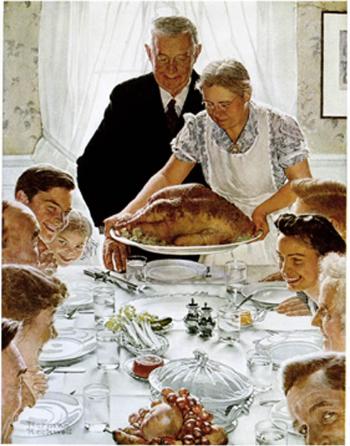
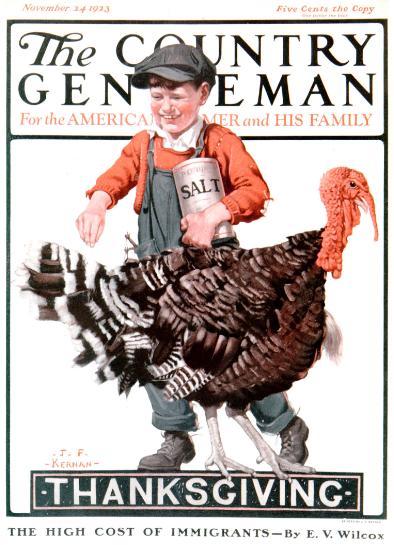
A View of Manhattan
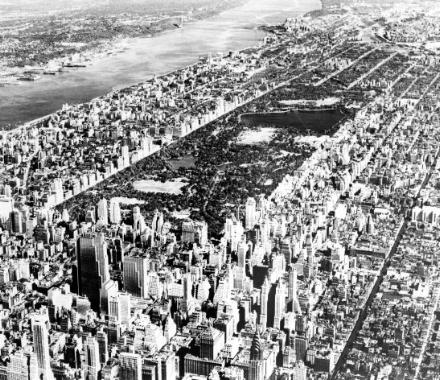
Wasn’t Manhattan more beautiful before the invasion of the glass boxes? I will tolerate Lever House and the U.N.; none further.
The Inverness IVs Head
Today we had the pleasure of participating in the Inverness IVs Head Race. It brought forth mixed results. The girls did really well, and one of the guys crews did really well. Our boat on the other hand managed to crash. Twice! But, you know, we added a dash of the spirit of Admiral Farragut, full speed ahead, etc., and still managed to finish the race. Only second to last. Pity the poor bastards who didn’t even manage to beat us. They would’ve had to have sunk or something not to have overtaken us.
Inverness is more or less the capital of the Highlands, thus it’s terribly far north. So far north that when we arrived I said “Why on earth would they stick a country so far north?” which most present found to be a generally amusing comment on the northerliness of our current position until one chap said “Well I’ve been skiing in Trondheim”. Mark my words, whenever one makes a salient point, there’s always someone who’s been skiing in Trondheim.
Nonetheless, we managed to return to St Andrews in a shockingly quick under three hours. I found a few minutes to chat online with Allison Burbage, who in conversation emphathised with the feeling that it is sometimes such a burden to be superior to so many people. Allison would know; she’s superior to most. Then she went away to nurse a G&T in the neighboring dorm room. These crazy kids.
Want To Buy A Seminary?
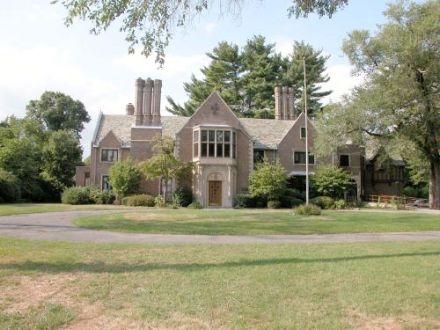
A while ago, we reported on the planned expansion of St. Nersess Armenian Seminary, the only Armenian seminary outside Armenia over in New Rochelle. Unfortunately, the seminary’s uppity neighbors got their proverbial knickers in a twist over the expansion and have pressured the City Council to deny planning permission (something that sounds very familiar to any Thorntonian; I guess the City of New Rochelle just doesn’t want outstanding educational institutions). Because of this the Board of St. Nersess met and decided it had to move elsewhere, so anyone who has a cool $15,000,000.00 to spare: it’s yours!
The house, on Stratton Road near Iona Prep, was built in the 1920’s by none other than William Randolph Hearst. He never lived there though, but just had it on hand for friends of his who were visiting New York and needed a place to stay. The building, to my recollection, is in fairly good condition, but the 8.65 acres it sits on seems rather small when you’re actually there.
Back in school we had some random day off that no other school had (Founder’s Day, I believe) and so Lucas de Soto and I, ever the adventurers, decided to pop over to the Armenian seminary to see what it was all about. (A Presbyeterian and a Catholic walk into an Armenian Seminary… sounds like the set-up for a bad joke). We turned up unannounced and everyone there was terrifically friendly. The secretary offered us cake, showed us around a bit and then introduced us to “the greatest expert on Armenian history ever” who was leaving for Philadelphia in under half an hour but would no doubt take a few minutes to answer any of our questions (unfortunately I’ve forgotten his name). He too was very friendly indeed and answered all our questions and told us about Armenia, the Church, the Armenian Patriarch of Jerusalem, and about the Divine Liturgy and how it differs from the Mass. We also got to chat with a few of the seminarians who were mulling about the kitchen. The historian even offered to teach us the Armenian language for free, and I was tempted to take them up on it. Lucas and I found it quite fascinating; well worth a day off from school.
For Their Tommorrow, We Gave Our Today


Strange as it may seem, Remembrance Day is perhaps my favorite time in the entire British year. It is somewhat surprising that despite the cultural revolution of the past few decades, despite the intellectual, academic, and political assaults on tradition, history, the military, and the time-honoured institutions of this realm, Remembrance Day remains and is widely commemorated. Three times this Remembrancetide I had the opportunity to partake in the annual two minutes silence: first, on the eleventh hour of the eleventh day of the eleventh month (Remembrance Day itself), then the following evening while watching the unbeatable Festival of Remembrance at the Royal Albert Hall on television, then the following morning at the Remembrance Sunday chapel service, which was followed by the joint service of town and gown at the War Memorial.
It is my firm belief that you can discern a great deal about a country from its ceremonial culture. From the naked paganism of Nazi Germany and the Stalinist banality of Soviet Russia to the splendid majesty of Great Britain and the restrained republicanism of the United States, rituals are not empty acts, but are indeed indicative of an inner soul, an essence.
Most of our readers will not be familiar with the workings of Remembrance Day in Britain. The climax to a typical Act of Remembrance is the two minutes of silence in remembrance of and thanksgiving for the great sacrifice made during all wars. Usually, there are two particular brief epigrams of sorts read, one before and one after the two minutes of silence.
They shall grow not old, as we that are left grow old:
Age shall not weary them, nor the years contemn.
At the going down of the sun and in the morning
We will remember them.
We will remember them.
When You Go Home,
Tell Them Of Us And Say,
For Their Tomorrow,
We Gave Our Today.
The two minutes of silence is one of the few remnants of dignity in this land. Two minutes in which the entire nation comes to a halt. Railway stations, public streets, shops, offices, even the busy stock exchange come to a complete halt as we stand, silently, to remember uncountable deeds and intangible sacrifice.
America, of course, does not have the culture of Remembrance Day, but celebrates the day as Veterans Day instead. The United States was exposed to the massive slaughter of modern warfare a full fifty years before the Great War so shocked Europe. To this day, no war has claimed the lives of as many Americans as did the Civil War, which led to the creation of Memorial Day. One of the many blessings bestowed upon our country is that we have never had to suffer on such a great scale in our own homeland again, while Europe has witnessed warfare as recently as a few years ago in the Balkans.
The Balkans was where it all started, after all, on that fateful day in Sarajevo, June 1914. The greatest reflection I have read this Remembrance Sunday was Gerald Warner’s column printed in the latest Scotland on Sunday. It is well worth registering with scotsman.com for. Read it.
Thoughts on NYU, et cetera
New York University is a very odd fish. It was founded (as the University of the City of New York) in the 1830’s as an academic refuge for the city’s Dutch Reformed and Presbyterians opposed to the very Episcopalian flavor of Columbia College, though it was never officially aligned to either denomination. Around the turn of the century when Columbia moved uptown to a brand spanking new beaux-arts campus NYU decided to follow suit by moving even further uptown and building their own classically-inspired campus. They kept their buildings in Greenwich Village, however, and by the 1970’s found the Bronx campus (University Heights) to be a burden on the old chequebook and sold it to the City.
In the meantime, NYU was known (and pretty much had been since it was founded) as a “commuter school”, which is to say that most (though not all) of its students were from around the metropolitan area who travelled from home to school and back again. This has completely changed in the 1980’s, as graduates who had done well for themselves (and other philanthropists) began donating large sums to NYU and it remade itself in the image of the normal residential university (again, like Columbia). Of course, having forsaken their proper campus they were stuck with a number of buildings around Greenwich Village and so pretty much began to buy up any building of any size that came onto the market in the neighborhood. [A commenter on Curbed.com says that NYU is probably the largest landowner in the City after Trinity Church. The largest landowner is actually the (Catholic) Archdiocese of New York, followed by Columbia University (which happens to own Rockefeller Center, among other things). After that, I’m not sure but NYU probably has more land, while I would think Trinity Chuch probably has higher returns for the particular land they own.] NYU is now an almost entirely residential university in that even if its students are not living in dorms they are almost certainly not living with their parents nearby. Indeed, the proportion of native New Yorkers has fallen while those from other states and countries has risen markedly.
I’ve had a fair amount of experience with NYU. According to facebook.com I have seven friends there, though one spent his freshman year there and wisely thought “This place is for suckers” and transferred to Georgetown, while another friend (now graduated) never bothered to join the Facebook. Anyhow, in my final year of high school I had a good friend who was a year older than me (a Holy Child girl, troublemakers all) who went to NYU. Most weeks I would head down one afternoon after school (always Mondays actually; I’m a creature of habit and it suited her schedule) and have dinner and, to use the parlance of our times, “hang out” and “chill” until heading back up to yonder Westchester around 9 o’clock. As you can imagine, one met a fair number of NYUers during such perambulations and I have to say, though the young lady in question did have a pretty roommate from Connecticut (a ‘Darienfrau’ as Igby Slocum would say, though she was actually from Guildford), I not even once met a single person with whom I might want to voluntarily spend any of my time. They were, to a man, boring, self-obsessed nitwits, completey devoid of anything interesting. Though (I’m told) a number of Columbians were irate at me for having described their academy as “a fallen institution”, fallen though it is Columbia is still better than NYU. I have not nearly spent the same amount of time at Columbia as I have down at NYU and yet I’ve met interesting people from there. Also, my mother works at Columbia and though she likes to tell many hilarious stories of the freaks she has met amongst the studentry, she also tells of a number of very kind, nice, and interesting students she has had the occasion to meet. I very much doubt this would be the case if she was working at NYU. The most interesting people at NYU are actually the security guards who, although they all take their jobs terribly seriously (and rightly so), are usually much better for some decent chat than the students. Of course, Fordham students are superb and beat NYUers and Columbians any day of the week.
But who, then, are the other NYUers whom I count amongst my friends? They still manage to be interesting folks. Strangely enough none of the eight Violets I know are friends with one another. In addition to the Holy Child girl and the wise Georgetown transfer, there is 3) a fellow Thorntonian (guy), 4) a Bronxvillian guy, 5) a hilarious girl from Larchmont whom I’m good friends with, 6) and 7) two girls, both Californian, I know from the summer I spent at Oxford, and 8) a girl who is a member of my Upper East Side circle of friends. The reader will note the preponderance of females. NYU is very much a feminine university these days; I mean, heck, their athletic nickname is the Violets after all, not the Fighting Irish. Of the guys I know, one’s only their because he’s exceptionally talented in the realm of film, another knew well enough to transfer away from NYU, and the third is a fellow Thorntonian (Thorntonians are known for either surviving in adverse situations or cracking up and going loony, so that accounts for his survival to date). Every NYU girl complains about the lack of available men since NYU predictably attracts a large number of men of… err… “alternative lifestyle options”. Naturally this creates a situation, like the Anglican priesthood, where being a male at NYU one might automatically be tarred with suspicions of being “of an alternative lifestyle” and thus a very large proportion of self-respecting young men are deterred from even applying.
But back to Curbed. So NYU is building yet another dorm and many are complaining about their precious neighborhood being turned into the quarter for spoiled students. Ah well. I’m not terribly troubled. Greenwich Village to me is part of Manhattan’s vast underbelly, a term I use only half abusingly. It’s just that most places below Gramercy Park seem either too crowded or too weird for me to live. It’s not that the underbelly is ugly, there are some beautiful buildings and some quite charming parts. But as the Brits say about France, “lovely place, shame about the people”. And you know, if you go for the SoHo/Chelsea/Village scene, then fair enough. Enjoy it all you like. I’m just an Upper East Side kinda guy myself.
The New Yorker Hunts
Windy Hollow, Millbrook, Rombout, Smithtown — doubtless these words mean nothing to many but to the huntsmen (and -women) of New York they are immediately recognised as the names of some of the Empire State’s hunts.
These four hunts are just some of the survivors but there were once many more packs of hounds across the state. Long Island before the second war was excellent hunt country but thanks to rapid suburbanisation and cultural changes only the Smithtown Hunt survives there.
Still, hunting loomed large enough in the imagination that it featured on the front cover of The New Yorker with some regularity.
Indeed the very week of the Kennedy assassination, houses up and down Manhattan and the whole East Coast would have had their copy of the magazine with a hunting scene front and centre. (President Kennedy did ride, but of the two of them it was the First Lady who was keener on the hunt.)
Here are just a few of the covers I’ve found.
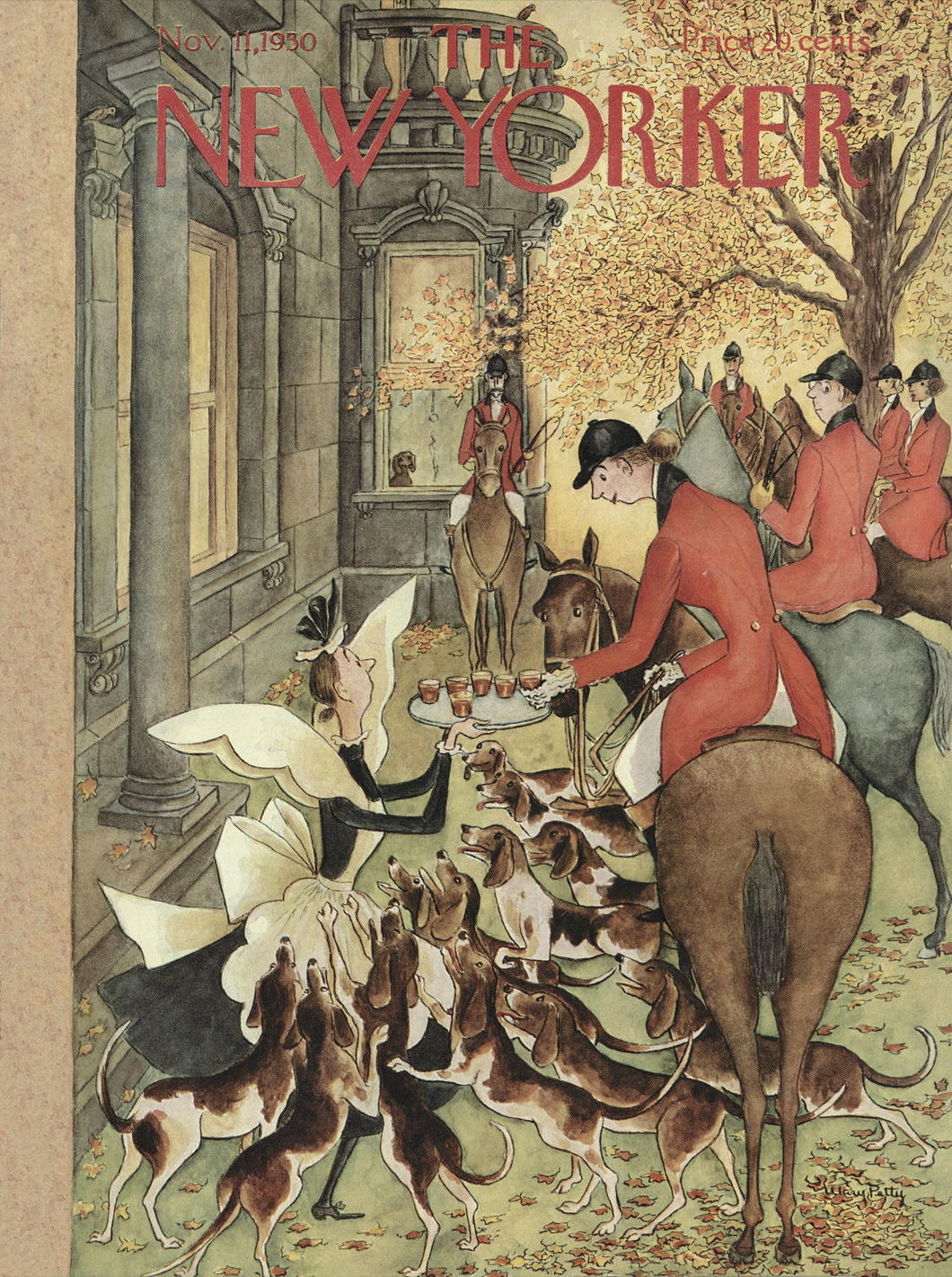
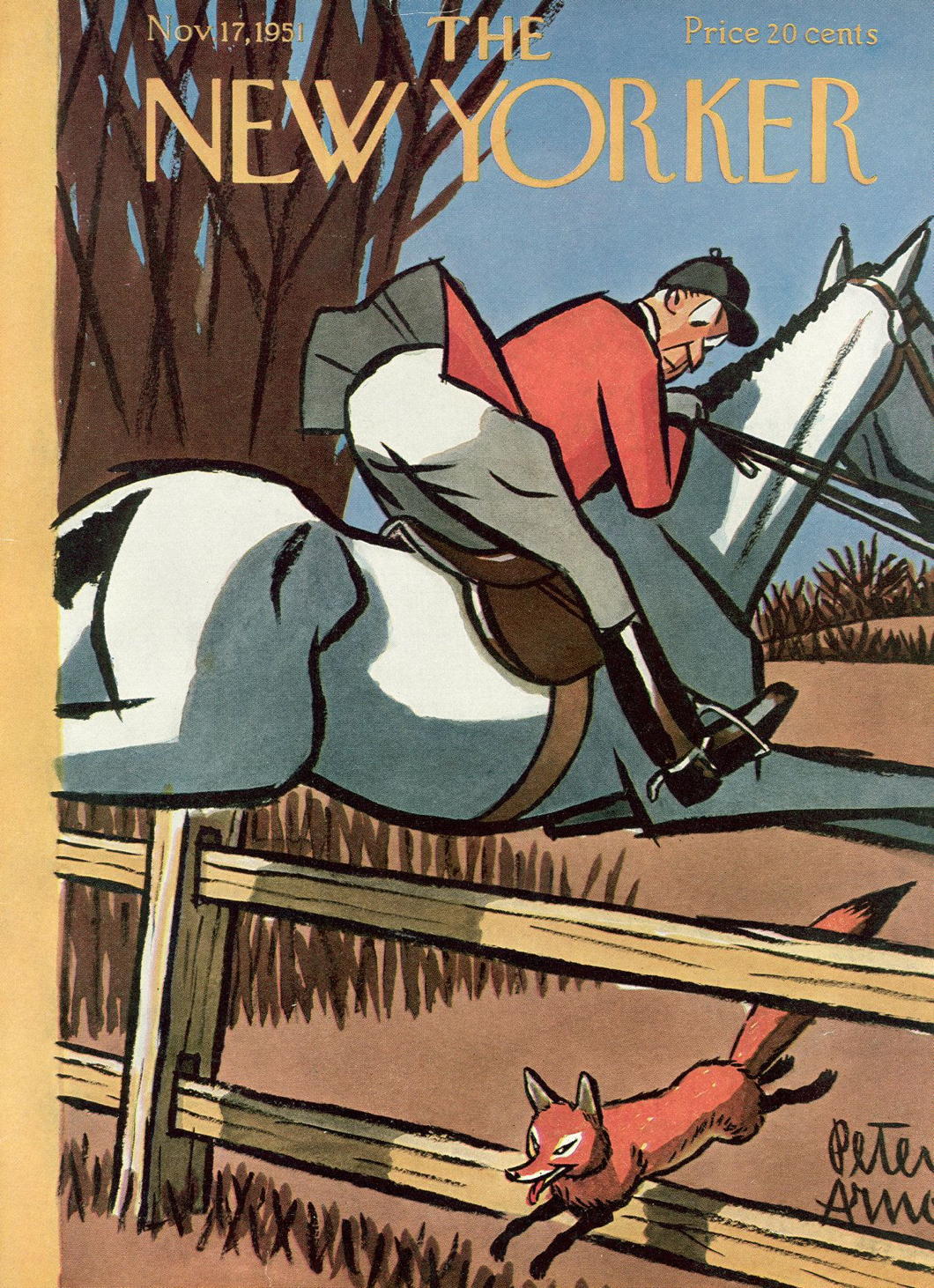
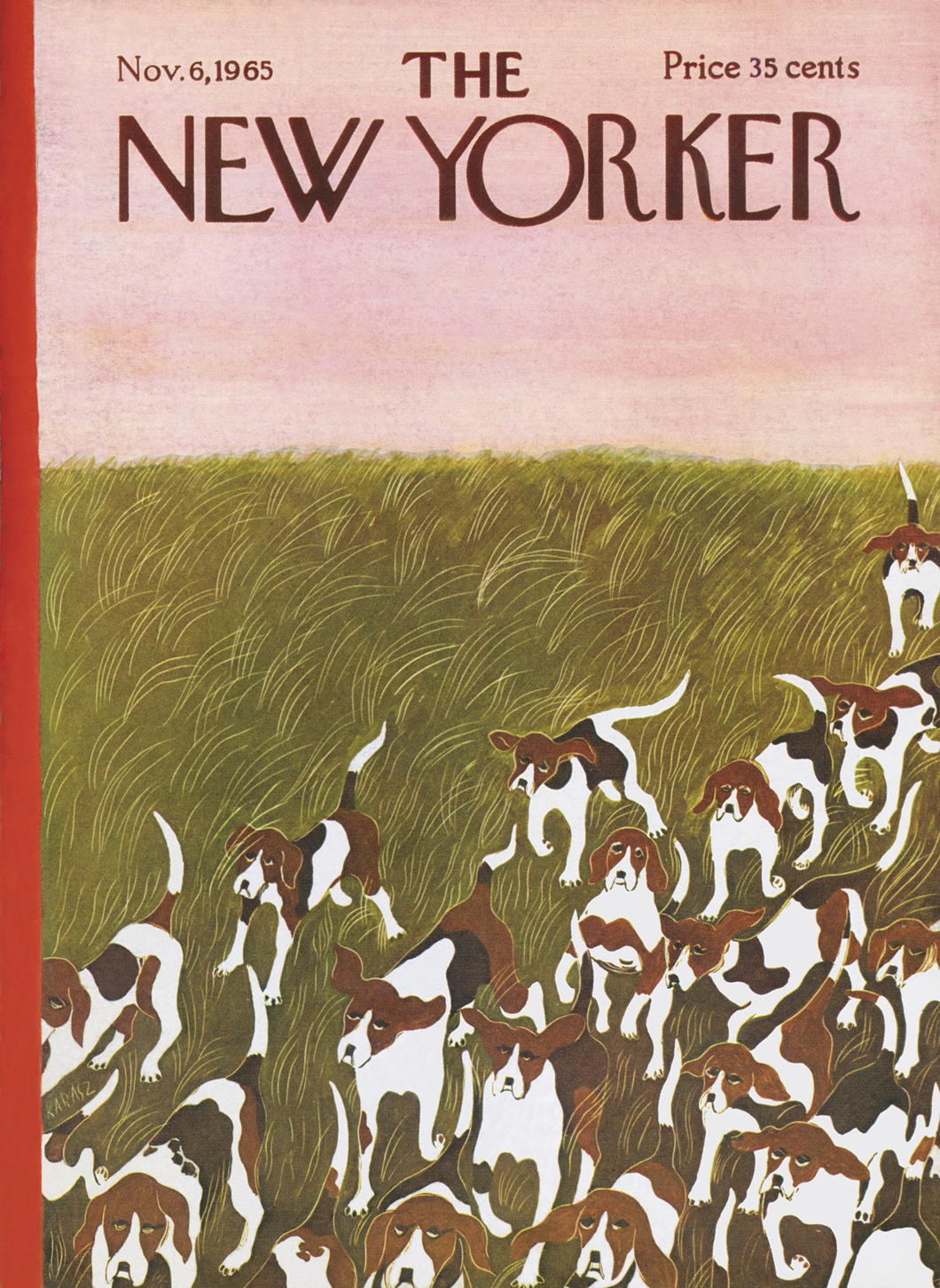
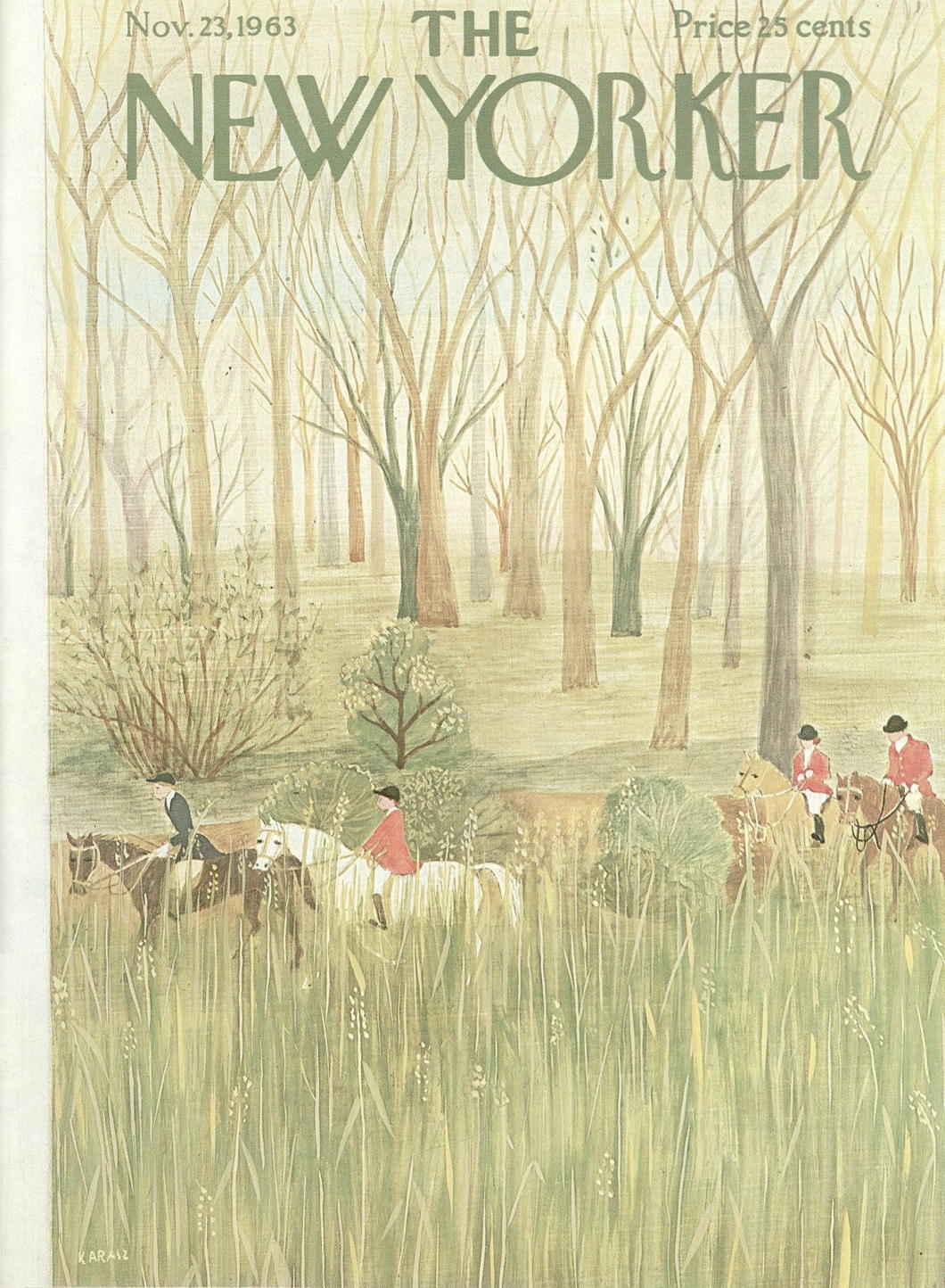
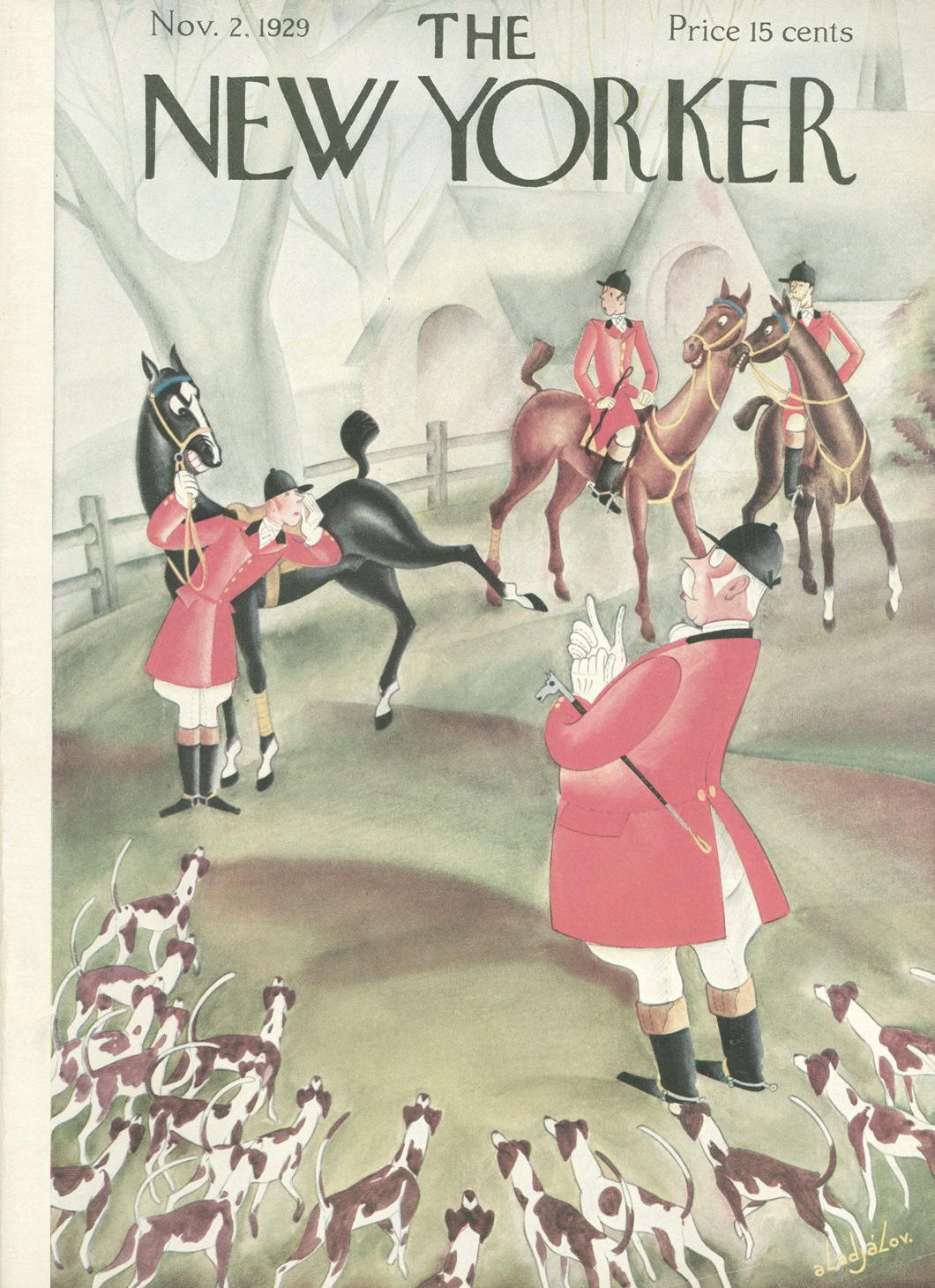
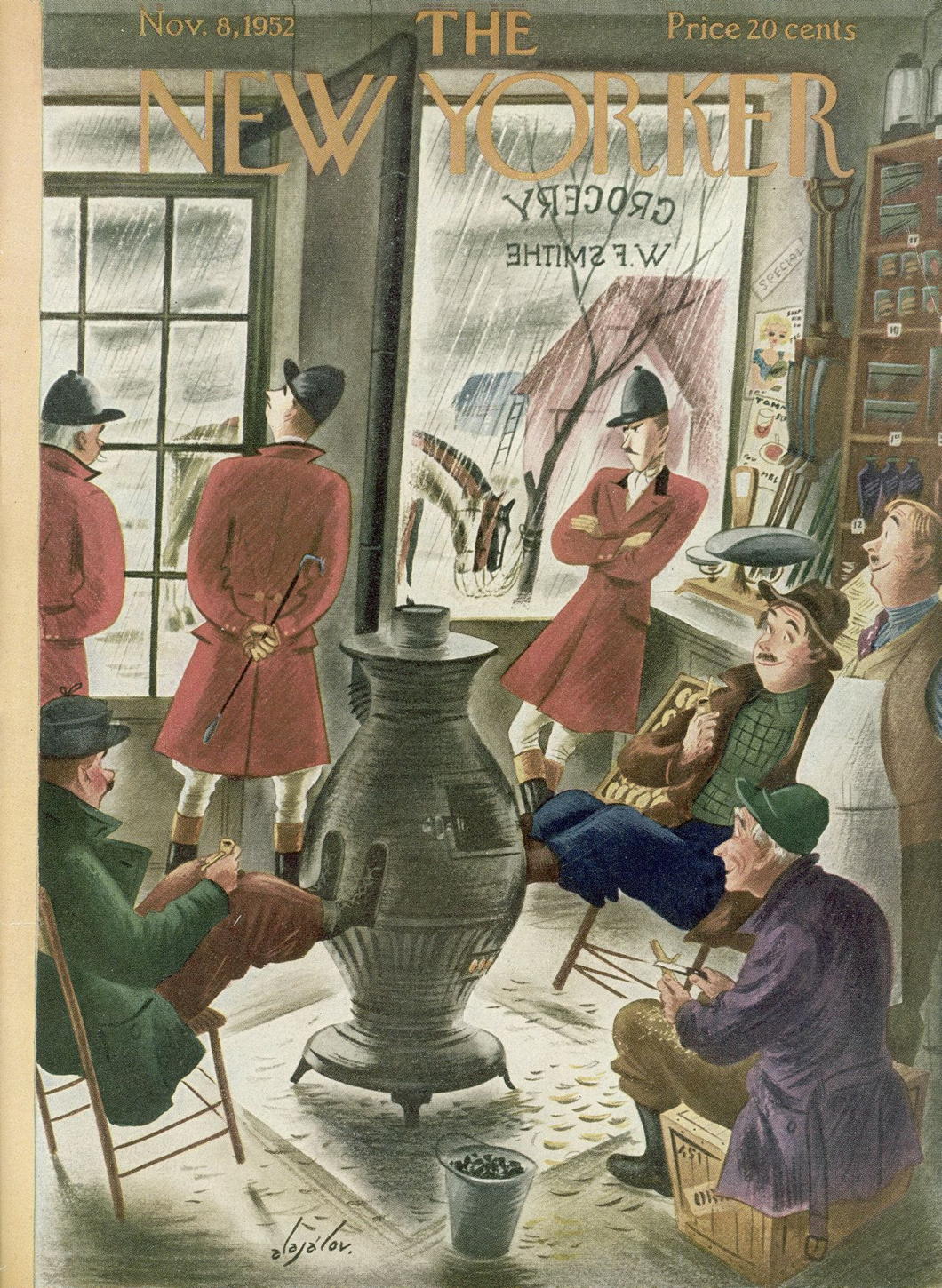
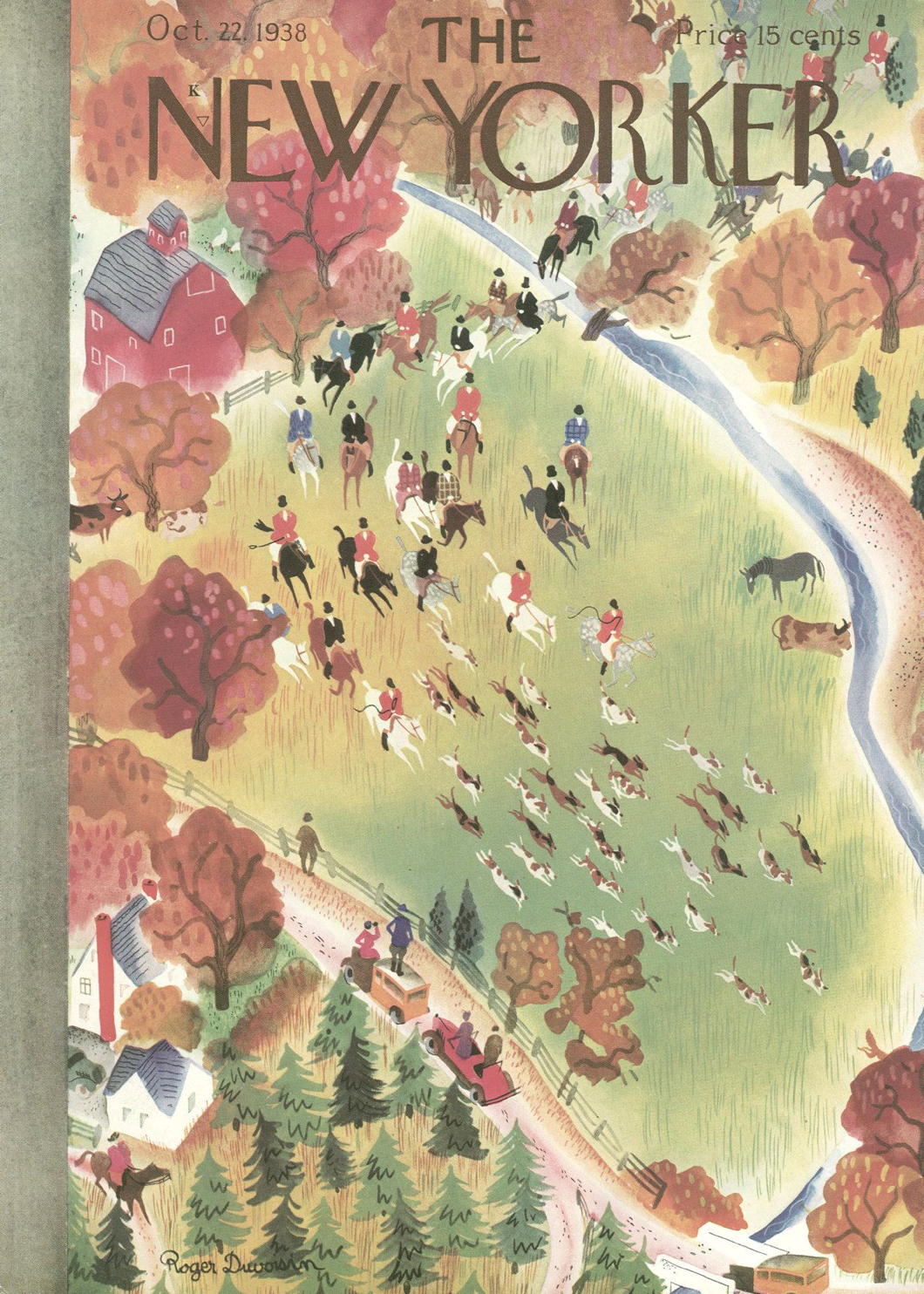
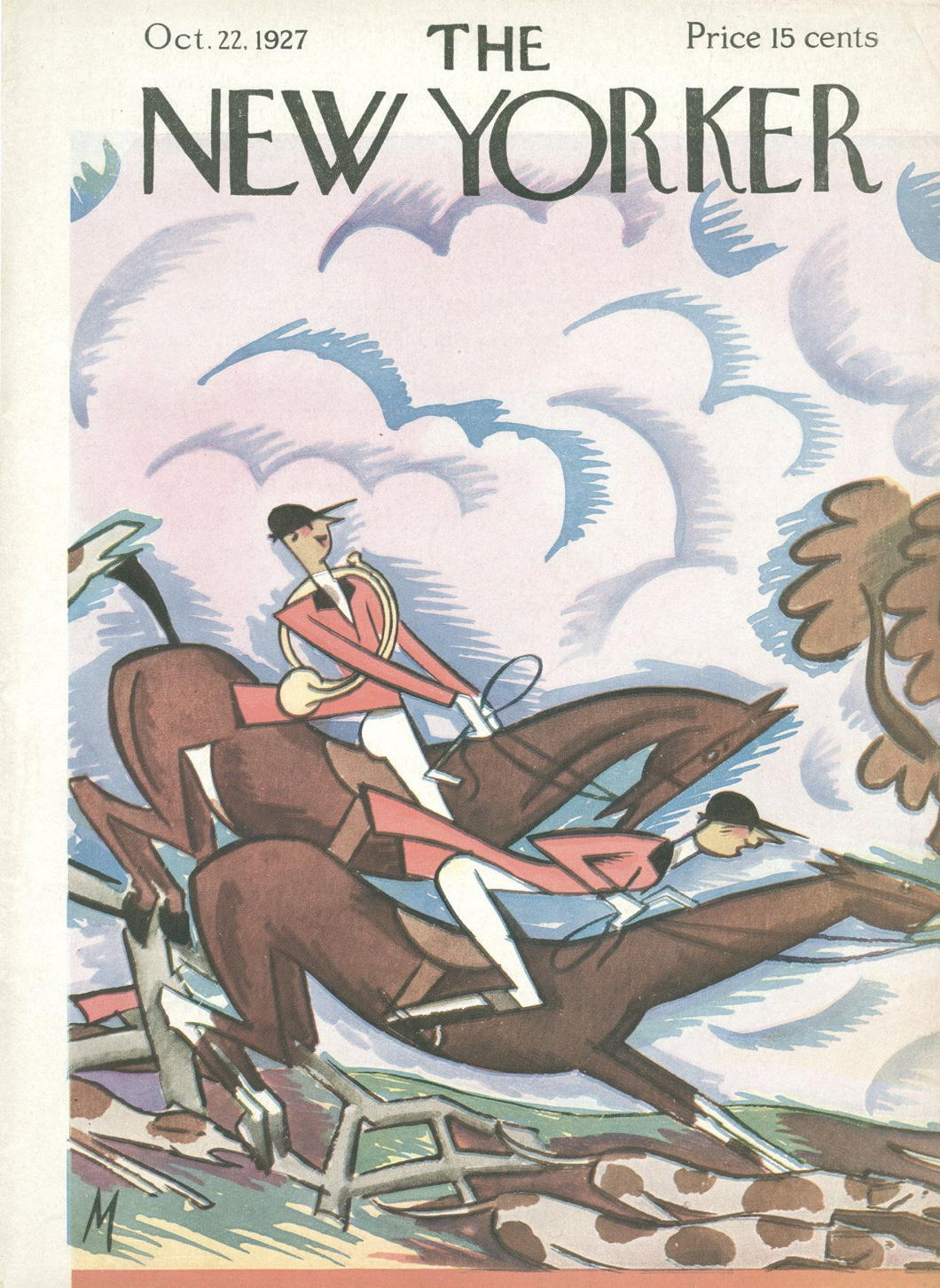
Tally Ho, Empire State!
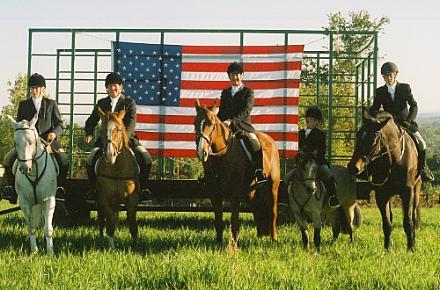
Much was made over the recent start of the hunt season here in the United Kingdom in spite of Comrade Blair’s ban, but New Yorkers mount their horses a little earlier. Above, a few members of the Windy Hollow Hunt in front of Old Glory.
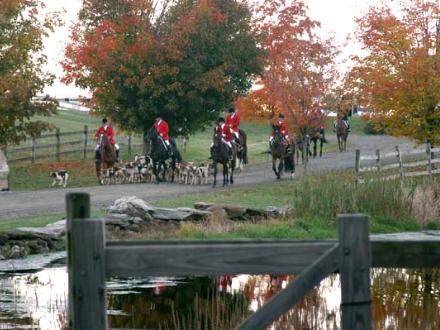
The Rombout Hunt, in the Hudson Valley.

This little fellow from Long Island’s Smithtown Hunt wants out so he can hunt down that dagnabbed fox!

The Smithtown Hunt in the field.
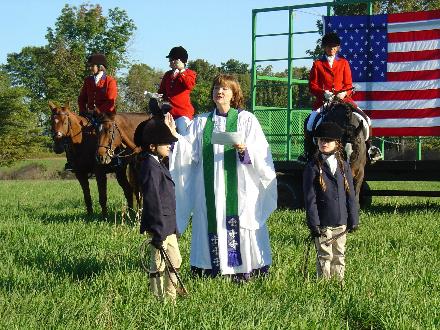
Of course not all things stay the same. This year Orange County’s Windy Hollow Hunt got a lady to perform the annual Blessing of the Hounds.
One of my favorite New Yorker cartoons has to do with the Blessing of the Hounds. I can’t find it online, so I’ll wait until I’m home and then scan in it for your enjoyment.
Below, the Genesee Valley Hunt.
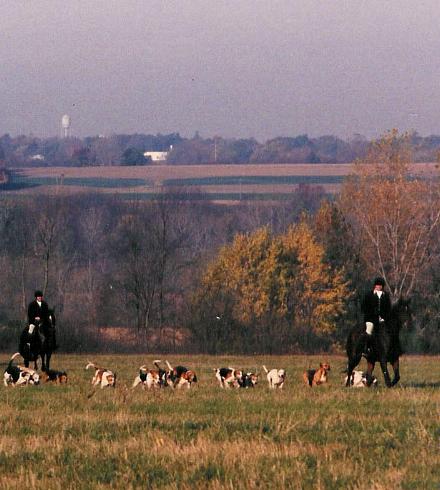
Dilbert on Gilbert
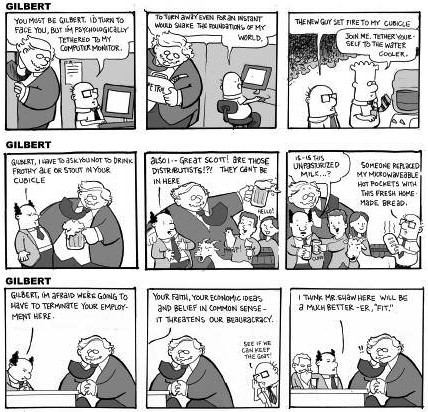
A recent Gilbert magazine featured G.K. himself interpolated into the popular Dilbert comic strip by Scott Adams. The text is quite small so I shall reproduce it below: (more…)
The New Shrine from Above
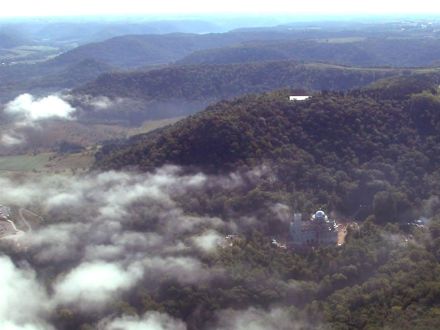
Via the Whapsters, we bring you this rather nifty shot of the Shrine of Our Lady of Guadalupe still under construction in the Diocese of LaCrosse, Wisconsin.
Previously: Patroness of the Americas
Walking the Dunes
Three sausages for breakfast, followed by reading from Gordon Brook Shepherd’s life of Empress Zita. Purchased my usual sugar doughring from Fisher and Donaldson and the latest Country Life from J&G Innes (all about London this week). The options for luncheon in hall were of asiatic origin so I boycotted and ate about half a loaf of buttered brown bread instead while reading Country Life in the Common Room of Canmore. There were a few people there; Adrian cataloguing the Catholic Truth Society pamphlets out of nothing better to do, Stefano sitting around waiting for his next tutorial, Liam lurking about, and “Ishmael” came in just to be social.
For a while we savaged Stefano because of his desire to show dirty films about Venetian courtesans in Canmore. Canmore, the Catholic Chaplaincy mind you, and Stefano is President of the Catholic Society. “Ishmael” and I slagged him off for being a dirty continental, which he just sort of brushed aside. We thought he was being a bit imperious, perhaps even episcopal, so we decided to turn the chair he was seated in into an impromptu sedia gestatoria. “Ishmael”, Adrian, Liam, and I each took one leg and raised His Foppishness aloft, processed him out of the Common Room, into the hallway, out the door, and into the street. We made as if we were going to give him the old heave-ho but eventually just put him down and ran back inside. Earlier he had taken off his shoes, and thus was stuck in the chair, in the street without any shoes on. By then we had gathered in the window to witness the poor man, yelling at us to carry him aloft “back into the palace”, gesticulating wildly, pointing out his lack of footgear. And we laughed. Oh, how we laughed. Eventually he got tired of our churlish manner and hopped back into the building, avoiding a puddle or two. “I hate you all,” he said, “and you didn’t carry me high enough,” then descending into ramblings about how at the next Catholic Society meeting the president should enter the room in a sedia. We resumed savaging him, and I had another slice of brown bread.
A little while later, I looked out towards the sea and the West Sands and felt them calling me forth. I had not gone for a walk along the beach yet this term, and it seemed as good a time as any. Though the sun was out I brought along my umbrella, just in case, and headed down past the Royal & Ancient Golf Club, past the putting green, and onto the Sands. Walks along the beach must be done at a very relaxed and leisurely rate. Every now and then I came across some driftwood or other such things that wash up on the beaches of Fife and gave them a little prod with my brolly and then, curiousity satisfied, carried along. I travelled about two thirds of the way down before seeking shelter from the breeze in one of the little dales within the dunes, took out some Marcus Aurelius that was hiding in my jacket pocket and had a little read. When I felt that my thirst for the wisdom of the ages was at least temporarily quenched, I decided to head back into town along the dune route. The beach is, as you would imagine, flat, whereas coming back along the dunes is a constant up and down through narrow sandy crevices with lots of reeds and tall grass on either side of you. If you ever visit St Andrews, you must go for a walk along the West Sands, and it’s advisable (if suitably agile) to walk at least partially along the dune paths.
Heading back into town, a Japanese couple asked me to take their photo in front of the R&A, and I duly obliged before slipping into the Quarto bookshop. The Quarto sells used books, and I had a good look around to see if there was anything new to peruse. I had a little read through a book on the history and traditions of the Channel Islands before heading back to hall, and here I am now, transcribing the day’s journey to you. Nothing left today but circuit training for the Boat Club, followed by a meeting of said august body. Hope it doesn’t last too long, else I’ll miss dinner. Some sort of pasta dish tonight; should be at least edible.
Previously: The West Sands
Bill and Ted
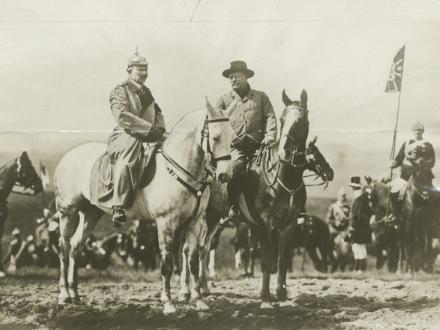
His Imperial Majesty Wilhelm II, the German Emperor, and His Excellency Mr. Theodore Roosevelt, President of the United States of America.
A Westchester Country House
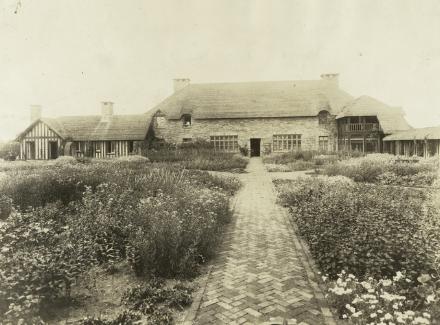
I’ve never heard of nor seen this house before. Unfortunately NYPL titles it merely as “A Westchester County Country House”. Not very helpful. I wonder if it’s still around. I rather like it. It has a nice simple, warm, cozy feel to it.
UPDATE: John Massengale informs us: “This is a house by Harrie T. Lindeberg. There’s a monograph of his work here. I haven’t looked at the book in a long time, but this might be the Stillman house in Pocantico Hills. Stillman was married to a Rockefeller, and the house is on the Rockefeller land there.”
Autumnal Bliss
As I was walking to Mass this morning, I enjoyed listening to the crunch and brush of leaves underfoot that so wonderfully heralds the autumnal season. Today is one of those beautiful fall days when the sun is shining, the air is crisp, the wind slight, and the temperature slightly chilled but nowhere near uncomfortable.
Yesterday evening I had the pleasure of dining with Mr. Michael Fryer, who is surely the funniest man in all of Fife (at least whenever he’s in Fife; he’s an Ulsterman after all). We were both lamenting the fact that, in spite of St Andrews advertising itself as the university at which one is most likely to find one’s spouse, both of us are in our fourth year and remain as yet without prospective permanent ladyfolk. Right then, Dr. Brian Lang (the Principal and Vice-Chancellor, the man who runs the University) happened to walk into the pub and I considered walking over and demanding a refund, but the conversation turned to subjects greater in mundanity.
Another great thing about this time of year is the wearing of the poppy. No one seems to be quite sure when Remembrancetide begins and when the poppy should first be worn. In the absence of any official protocol to my knowledge, I usually judge that as soon as the Scottish Poppy Appeal start collecting money and distributing poppies, then is the time for wearing them. When it comes to Remembrance Sunday itself, I never miss the Festival of Remembrance broadcast on the telly, and neither should you. It’s a disgrace that it’s not broadcast on the web for those throughout the world unable to see it on their televisions. Still, it’s great to see so many poppies worn about town by young and old alike.
Later on last evening I had the added bonus of a pint and smoke with another Irishman, Mr. Alexander O’Hara of Galway. Alec and I are both fans of the pipe, and we enjoyed a good pint and some conversation a little late into the evening. Alec’s company is enjoyable because, like me, he is anti-social, and there are few things more enjoyable than being anti-social with other anti-social people. He’s in the midst of his doctoral thesis on Norwegian saints, which means he has to nitpick through various Latin manuscripts, translating them himself. Poor man! Still, he’ll have something to show for it at the end.
Well, unfortunately there’s work to be done so I must be off. A very happy All Saints’ Day to you all!
Search
Instagram: @andcusack
Click here for my Instagram photos.Most Recent Posts
- Silver Jubilee November 21, 2024
- Articles of Note: 11 November 2024 November 11, 2024
- Why do you read? November 5, 2024
- India November 4, 2024
- The Lithe Efficiency of the Old Constitution November 4, 2024
Most Recent Comments
Book Wishlist
Monthly Archives
Categories

